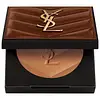What's inside
What's inside
 Key Ingredients
Key Ingredients

 Benefits
Benefits

 Concerns
Concerns

 Ingredients Side-by-side
Ingredients Side-by-side

Synthetic Fluorphlogopite
Mica
Cosmetic ColorantMagnesium Myristate
Lauroyl Lysine
Skin ConditioningDimethicone
EmollientCalcium Sodium Borosilicate
Silica
AbrasiveIsodecyl Neopentanoate
EmollientTrimethylsiloxysilicate
EmollientSodium Hyaluronate
HumectantPolypropylsilsesquioxane
Caprylyl Glycol
EmollientDiisostearyl Malate
EmollientDimethiconol
EmollientPhenoxyethanol
PreservativeHexylene Glycol
EmulsifyingCaprylic/Capric Triglyceride
MaskingPolyhydroxystearic Acid
EmulsifyingTriethoxycaprylylsilane
Isostearic Acid
CleansingLecithin
EmollientPolyglyceryl-3 Polyricinoleate
EmulsifyingCI 77491
Cosmetic ColorantCI 77492
Cosmetic ColorantCI 77499
Cosmetic ColorantCI 77742
Cosmetic ColorantSynthetic Fluorphlogopite, Mica, Magnesium Myristate, Lauroyl Lysine, Dimethicone, Calcium Sodium Borosilicate, Silica, Isodecyl Neopentanoate, Trimethylsiloxysilicate, Sodium Hyaluronate, Polypropylsilsesquioxane, Caprylyl Glycol, Diisostearyl Malate, Dimethiconol, Phenoxyethanol, Hexylene Glycol, Caprylic/Capric Triglyceride, Polyhydroxystearic Acid, Triethoxycaprylylsilane, Isostearic Acid, Lecithin, Polyglyceryl-3 Polyricinoleate, CI 77491, CI 77492, CI 77499, CI 77742
Talc
AbrasiveSilica
AbrasivePerlite
AbsorbentCaprylic/Capric Triglyceride
MaskingBoron Nitride
AbsorbentOctyldodecyl Stearoyl Stearate
EmollientMagnesium Stearate
Cosmetic ColorantSynthetic Fluorphlogopite
Caprylyl Glycol
EmollientNiacinamide
SmoothingSodium Hyaluronate
HumectantTin Oxide
AbrasiveCitrus Limon Peel Extract
EmollientCI 77491
Cosmetic ColorantCI 77492
Cosmetic ColorantCI 77499
Cosmetic ColorantCI 77891
Cosmetic Colorant
 Reviews
Reviews

Ingredients Explained
These ingredients are found in both products.
Ingredients higher up in an ingredient list are typically present in a larger amount.
This ingredient is an emollient, solvent, and texture enhancer. It is considered a skin-softener by helping the skin prevent moisture loss.
It helps thicken a product's formula and makes it easier to spread by dissolving clumping compounds.
Caprylic Triglyceride is made by combining glycerin with coconut oil, forming a clear liquid.
While there is an assumption Caprylic Triglyceride can clog pores due to it being derived from coconut oil, there is no research supporting this.
Learn more about Caprylic/Capric TriglycerideCaprylyl Glycol is a humectant and emollient, meaning it attracts and preserves moisture.
It is a common ingredient in many products, especially those designed to hydrate skin. The primary benefits are retaining moisture, skin softening, and promoting a healthy skin barrier.
Though Caprylyl Glycol is an alcohol derived from fatty acids, it is not the kind that can dry out skin.
This ingredient is also used as a preservative to extend the life of products. It has slight antimicrobial properties.
Learn more about Caprylyl GlycolCi 77491 is also hydrated iron III oxide. It's sole purpose is to give a red/pink hue to products.
Iron III oxides are classified as inorganic chemicals for coloring.
Synthetically created Ci 77491 is considered safer than those naturally found. This is because the synthetically created version may contain less impurities. Iron oxides are generally non-toxic and non-allergenic.
Learn more about CI 77491Ci 77492 is also hydrated iron III oxide. It's sole purpose is to give a yellow hue to products.
Iron III oxides are classified as inorganic chemicals for coloring.
Synthetically created Ci 77492 is considered safer than those naturally found. This is because the synthetically created version may contain less impurities. Iron oxides are generally non-toxic and non-allergenic.
Learn more about CI 77492Ci 77499 is also hydrated iron III oxide. It is created from mixing red and black iron oxides. This helps give shades of darkness to a product.
Iron III oxides are classified as inorganic chemicals for coloring.
Silica, also known as silicon dioxide, is a naturally occurring mineral. It is used as a fine, spherical, and porous powder in cosmetics.
Though it has exfoliant properties, the function of silica varies depending on the product.
The unique structure of silica enhances the spreadability and adds smoothness, making it a great texture enhancer.
It is also used as an active carrier, emulsifier, and mattifier due to its ability to absorb excess oil.
In some products, tiny microneedles called spicules are made from silica or hydrolyzed sponge. When you rub them in, they lightly polish away dead skin layers and enhance the penetration of active ingredients.
Learn more about SilicaSodium Hyaluronate is hyaluronic acid's salt form. It is commonly derived from the sodium salt of hyaluronic acid.
Like hyaluronic acid, it is great at holding water and acts as a humectant. This makes it a great skin hydrating ingredient.
Sodium Hyaluronate is naturally occurring in our bodies and is mostly found in eye fluid and joints.
These are some other common types of Hyaluronic Acid:
Learn more about Sodium HyaluronateSynthetic Fluorphlogopite is the synthethic version of mica. It consists of fluorine, aluminum and silicate.
Synthetic Fluorphlogopite is used to add volume to products.
It is considered non-irritating on the skin.
Learn more about Synthetic Fluorphlogopite